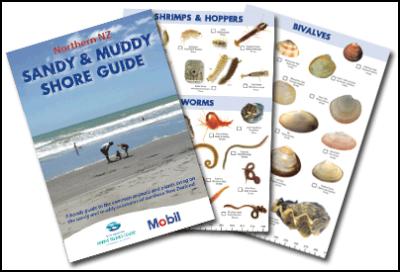Sandy & Muddy Shore Guide Released During Seaweek

University of Otago Sandy & Muddy Shore Guide Released During Seaweek
The University of Otago’s New
Zealand Marine Studies Centre is launching a Sandy &
Muddy Shore Guide this weekend, continuing its hugely
popular series of guides to the diversity of life found on
our shores.
Sponsored by Mobil New Zealand Ltd, the free Sandy & Muddy Shore Guide is being launched on 2 March in Auckland as part of the opening of Seaweek (www.seaweek.org.nz). The guide’s photographs help identify 100 common plants and animals living on New Zealand's sandy and muddy shores and estuaries.
An initial printing of 20,000 each of Northern and Southern versions of the Sandy & Muddy Shore Guide will be distributed throughout the country and to all New Zealand schools during Seaweek.
“We expect this guide to be as popular as our Rocky Shore Guide, of which over 100,000 copies have been printed and distributed since its release in 2010,” says NZ Marine Studies Centre Programme Director Sally Carson.
“There has been a lot of demand from schools around the country. They say ‘the Rocky Shore Guide is great but our local beach is a sandy beach!’.
“At first glance muddy and sandy shores appear barren, but look beneath the surface and you will find a rich diversity of life: “ngā tini o te waitai” (the multitudes of the sea). Northern and Southern versions have been compiled to highlight New Zealand’s regional differences.
“Recent reports estimate that over 17,000 marine species live in New Zealand waters, with over half of these found nowhere else in the world, and sandy and muddy shores are no exception. From tiny worms to burrowing crabs, this is a world like no other.”
Ms Carson says the latest guide differs from the Rocky Shore Guide.
“This time we have included evidence of what to look for on the surface to identify what hides below. We’ve included pictures of burrow entrances, or faecal casts that will give you an indication of what lives there without digging up the beach. We’re asking those using the guide, communities, families and schools, to be detectives and look for evidence of life.”
Both the Sandy & Muddy Shore Guide and the Rocky Shore Guide contribute to the wider Marine Metre Squared project, a ‘citizen science’ project that encourages the public to pick a patch of the shore and, with the help of information found on the project website, www.mm2.net.nz, survey the biodiversity within a one metre square area.
“We not only encourge people to identify what’s on the shore, but to count it, too,” Ms Carson says. “For sandy and muddy shores it’s a bit more involved than for the rocky shore, because to count the life-forms you dig up a tin-full of sand and, using a kitchen sieve, find the worms or shells in it. Then you upload the information on the mm2 website to share your findings with researchers, schools and other interested people.
“Ultimately it is hoped that the project will facilitate partnerships between scientists, schools, community and iwi groups that will lead to improved coastal management.”
The Sandy & Muddy Shore Guide has been developed by staff at the NZ Marine Studies Centre with input from the University of Otago’s Departments of Marine Science and Zoology, University of Auckland’s Leigh Marine Laboratory, and National Institute of Water and Atmospheric Research (NIWA). St Hilda’s Collegiate School teacher Derrith Bartley also made a significant contribution while on an Endeavour Teacher Fellowship at the NZ Marine Studies Centre.
New Zealand Marine Studies Centre staff and volunteers will be in Dunedin’s Meridian Mall distributing the guides on Saturday 1 March. They are encouraging the public to head to one of six Dunedin sandy or muddy shores on Sunday 2 March at 10.30am to take part in a survey of marine species living there.
• Macandrew Bay (meet at the beach) – coordinator Davina Hunt – Ph 021 155 5755
• Port Chalmers (meet at Mussell Bay, the beach behind Port Chalmers School) – coordinator Andrew Inness, Ph. 477 4674 or Adelle O’Neill, Ph. 479 5826 or 472 7254.
• Portobello Bay (meet in Hatchery Road near Dairy) – coordinator Tessa Mill,s Ph. 479 5826 or 478 0110
• Taieri Mouth (meet on the mudflats by Riverside Road) – coordinator Lucy Hardy – Ph. 474 7094 or 481 1224
• Tomahawk Beach (meet at the carpark) – coordinator Victoria Rosin – Ph. 027 306 0352.
• Warrington Beach (meet on the mudflat, at the end of the gravel road that runs from the playground to the estuary) – coordinator Derrith Bartley – Ph 454 3463 or 021 025 448 83.
Copies of the guide may be ordered by emailing marine-studies@otago.ac.nz or they can be downloaded from the web site www.marine.ac.nz
ENDS
Related
links
Marine Metre Squared
www.mm2.net.nz
Seaweek
2013
www.seaweek.org.nz


 Tourism New Zealand: Tourism New Zealand Invites The World To Find Their 100% Pure New Zealand In New Global Campaign
Tourism New Zealand: Tourism New Zealand Invites The World To Find Their 100% Pure New Zealand In New Global Campaign Bill Bennett: Comcom warns 2degrees over satellite marketing
Bill Bennett: Comcom warns 2degrees over satellite marketing Transpower: Major Electricity Development For Western Bay Of Plenty A Step Closer
Transpower: Major Electricity Development For Western Bay Of Plenty A Step Closer Alcohol Beverages Council: Turning The Tide - New Zealanders Unite To Curb Harmful Drinking
Alcohol Beverages Council: Turning The Tide - New Zealanders Unite To Curb Harmful Drinking University of Auckland Business School: Economists Urge Action To Prevent ‘AI Poverty Traps’
University of Auckland Business School: Economists Urge Action To Prevent ‘AI Poverty Traps’ Bill Bennett: Australian warship takes rural fixed wireless broadband offline
Bill Bennett: Australian warship takes rural fixed wireless broadband offline


